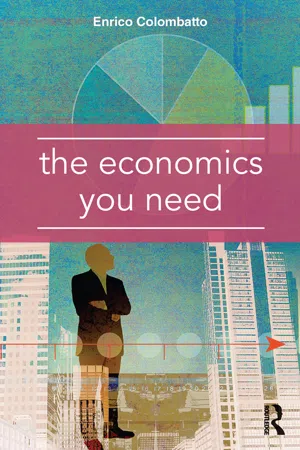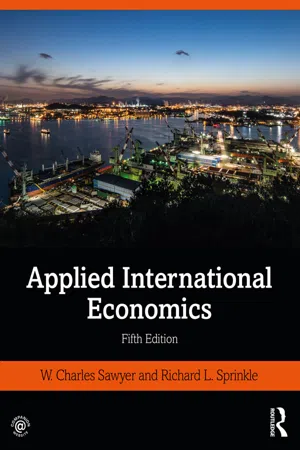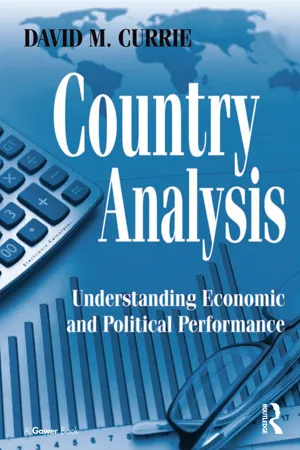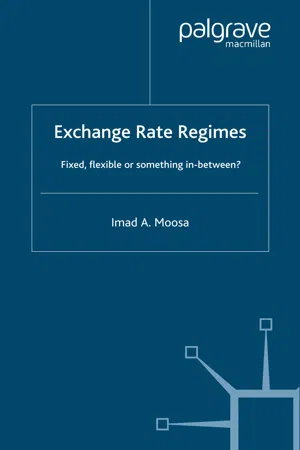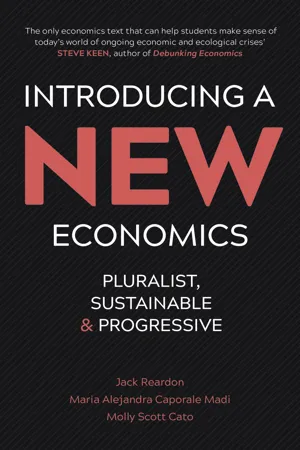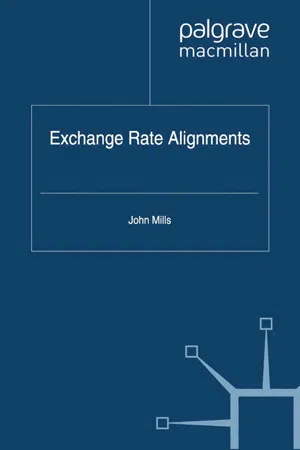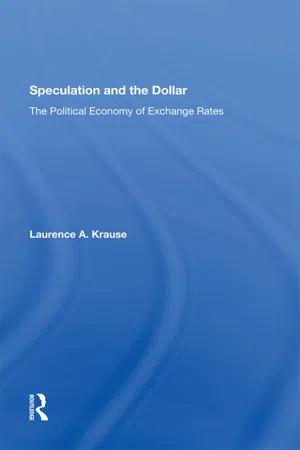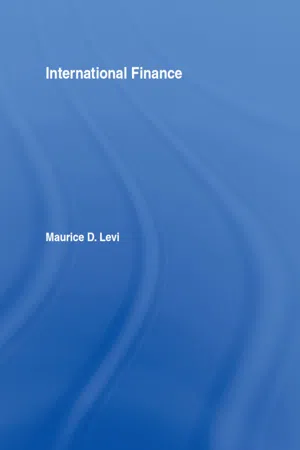Economics
Exchange Rate
An exchange rate is the value of one currency in terms of another. It represents the rate at which one currency can be exchanged for another. Exchange rates play a crucial role in international trade and finance, impacting the cost of imports and exports, as well as influencing investment flows between countries.
Written by Perlego with AI-assistance
Related key terms
1 of 5
10 Key excerpts on "Exchange Rate"
- eBook - ePub
- Enrico Colombatto(Author)
- 2016(Publication Date)
- Taylor & Francis(Publisher)
9 Exchange RatesDOI: 10.4324/9781315658988-109.1 An introduction to Exchange Rates
International trade is usually known as the ‘real’ side of international economics. By contrast, the monetary side focuses on Exchange Rates, i.e. on the rates at which currencies are converted into – and exchanged for – other currencies. The need for conversion originates from the fact that agents frequently operate in different monetary units, but economic decisions require costs and revenues to be comparable, and thus expressed in the same unit. For example, if the parties involved in a transaction agree to use the sellers’ currency, buyers are obviously interested in knowing how much purchasing power they must sacrifice in order to acquire what they are about to buy. On the other hand, if the parties agree on using the buyers’ monetary standard, then sellers want to make sure that the price they get is consistent with their costs and business plans. Similar comments apply when two agents – say, an Indian and a Thai – decide to operate in a third currency (e.g. the US dollar).Of course, Exchange Rates are not only a convenient way of registering transactions and enhancing accounting practices. Exchange Rates are also important because operators must buy and sell foreign currencies in order to pay for foreign goods or to obtain the domestic monetary units with which to buy domestic inputs. The Exchange Rate, therefore, is also the rate at which individuals buy/sell currencies with a view to expanding the range of their economic transactions.The study of the variables that affect the dynamics of currency markets is the core of exchange-rate economics, which usually follows different lines of reasoning depending on the regime adopted by a country or group of countries. By and large, the nature and degree of government intervention give origin to five different exchange-rate regimes: the gold standard (sections 9.2–9.5), flexible-Exchange Rates (sections 9.6–9.10), fixed-Exchange Rates (section 9.11), currency boards (section 9.12) and monetary unions (section 9.13). For each regime, this chapter illustrates the underlying working assumptions, some of the consequences the various regimes generate with regard to the domestic economy, the extent to which government commitments are credible, and the variables that affect adjustment. - eBook - ePub
- W. Charles Sawyer, Richard L. Sprinkle(Authors)
- 2020(Publication Date)
- Routledge(Publisher)
T he international value of a country’s currency has become an inescapable part of the daily flow of economic information. Most of us are aware that a country’s Exchange Rate is important, but many of us do not have a clear idea of why the Exchange Rate matters or what causes it to change. As the chapter’s opening quote indicates, the familiar tools of supply and demand analysis can be used to determine a country’s Exchange Rate. In this chapter, you will learn why the supply and demand model works in analyzing Exchange Rates—in the same manner, in fact, that it works in analyzing the price of gasoline or pizza, for one dollar or one yen or one gallon of gasoline is indistinguishable from another. By the end of this chapter you should have a good grasp of why Exchange Rates are important and what factors cause them to change over the long run. Finally, it is obvious to even a casual observer that Exchange Rates change frequently. These changes, or volatility, are a source of aggravation for individuals, businesses, and governments. The chapter explains what economists know about the effects of Exchange Rate volatility on international trade and how changes in Exchange Rates affect the prices of the goods and services we purchase. The final part of the chapter deals with the underlying value of a currency. While the Exchange Rate we observe in the market often differs from that value, it is very useful to know what that value is.Exchange RateSSuppose that a U.S. importer is purchasing British Jaguars. To purchase the Jaguars, the importer needs to obtain British pounds by exchanging dollars for pounds. The demand for foreign currency is derived from individuals demanding foreign goods and services. This relationship can be applied in reverse. As individuals in the U.K. demand U.S. products, there is an increased demand for dollars. However, this raises the question of how many dollars must be exchanged to obtain the requisite number of pounds, or vice versa? In this example, the relevant Exchange Rate is the U.S. dollar–U.K. pound Exchange Rate. In general, the Exchange Rate is the price of one country’s currency in terms of another. The demand for British pounds relative to the supply of pounds will determine the Exchange Rate, just as the demand for gasoline relative to the supply of gasoline determines the price of gasoline. Exchange Rates fluctuate considerably over time. However, unlike the price of gasoline, changes in the Exchange Rate are expressed as changes in the value of the domestic country’s currency. An increase in the value of a currency is referred to as appreciation. Analogously, a decline in the value of the currency is referred to as depreciation.For example, let us assume that the Exchange Rate is $2 per pound, which means that one pound costs $2. If the Exchange Rate increases to $3 per pound, we would say that the dollar has depreciated. Although the price has risen, each U.S. dollar is now worth less relative to British pounds. It now takes more dollars to buy a pound than it did before. If the Exchange Rate declines from $2 per pound to $1 per pound, we would say that the dollar has appreciated, as it now takes only $1 to buy one pound. - eBook - ePub
Country Analysis
Understanding Economic and Political Performance
- David M. Currie(Author)
- 2016(Publication Date)
- Routledge(Publisher)
explain the factors that influence the value of a currency; 6. explain the difference between fixed and floating Exchange Rate regimes; 7. explain the risk in a currency transaction caused by appreciation or depreciation of either currency. What is an Exchange Rate? An Exchange Rate is simply a price that tells you how much a currency is worth in terms of another currency. Because this book is intended for a US audience, most of the discussion will be in terms of how much a US dollar is worth, but the same reasoning applies to any other currency: how much a UK pound is worth in terms of euros, or how much a euro is worth in terms of Japanese yen. Any currency can be stated relative to another currency, and the price is its Exchange Rate. The Exchange Rate can be established in two ways: by the government of a country, or by the international currency market. In the old days, before the Second World War, governments set Exchange Rates that initially were based on the gold content of each country’s coins. When that system ran into complications, rates were set by agreements between governments in what was known as the Bretton Woods system. When the Bretton Woods system failed in the 1970s, most governments left it to markets to determine Exchange Rates. With a few notable exceptions, today most Exchange Rates are determined on the currency market. When a government sets an Exchange Rate and attempts to maintain that value, it is called a fixed Exchange Rate regime. When governments give up the effort and allow markets to determine Exchange Rates, it is called a floating Exchange Rate regime. Between the two extremes are several variations, but those are the choices facing any government: the government can attempt to dictate the Exchange Rate, or it can leave the decision up to the market - eBook - PDF
Exchange Rate Regimes
Fixed, Flexible or Something in Between?
- I. Moosa(Author)
- 2006(Publication Date)
- Palgrave Macmillan(Publisher)
2 The Role of the Exchange Rate in the Economy Macroeconomic linkages through Exchange Rates The Exchange Rate provides a key macroeconomic linkage between the domestic economy and the rest of the world that takes place through the goods and asset markets. In the goods market, the Exchange Rate establishes linkages between domestic and foreign prices through the relationship P ¼ þ EP ð2:1Þ where P is domestic prices, P* is foreign prices and the Exchange Rate is expressed as the domestic currency price of one unit of the foreign currency. The parameters that reflect transaction costs and other market imperfections are and . This is a linear relationship between domes- tic prices and foreign prices expressed in domestic currency terms. It shows that the higher the Exchange Rate, other things being equal, the higher the price of foreign goods in the home country (@P/@E > 0). The same relationship can be seen in Figure 2.1, which depicts P as a func- tion of P*. As the Exchange Rate rises (the domestic currency depreciates) the line P ¼ þ EP* rotates upwards, leading to higher P for the same level of P*. This happens either directly (because the domestic price of imported goods rises) or indirectly (because domestic firms can afford to raise their prices when competitors’ prices rise). Some of the effect is transmitted through the labour market, as workers may demand wage increases when higher import prices raise the cost of living. Govern- ments that are aware of this connection would prefer to stop depreci- ation but if they do so in the face of domestic inflation they risk a loss in competitiveness. Naturally, the effect of domestic currency appreciation 29 on domestic prices can be augmented by a rise in foreign currency prices as shown in Figure 2.2. On the other hand, it can be seen in Figure 2.3 that domestic currency appreciation (falling Exchange Rate) can offset the effect of rising foreign prices. - eBook - ePub
Introducing a New Economics
Pluralist, Sustainable and Progressive
- Jack Reardon, Maria Alejandra Caporale Madi, Molly Scott Cato(Authors)
- 2017(Publication Date)
- Pluto Press(Publisher)
If every nation in the world used the same currency, or, for that matter, if there was only one nation in the world – neither of which is very likely, or desirable – then the topic of Exchange Rates would be irrelevant. However, given that there are many nations and many currencies, and that these nations would like to trade with each other, the topic of Exchange Rates must be discussed.Let us define an Exchange Rate as: the price of one currency in terms of another.1 From this it is clear that this relationship is reciprocal, since one currency is always measured in relation to another, i.e. rather than say that the US dollar, for example, increased in value, we must say that the value of the dollar increased in relation to a specific currency, such as the European euro or the Japanese yen. And, since we measure one currency in terms of another, if one decreases in value, the other by definition increases.In July 2015, 1 British pound was worth US$1.56. This means that if you had visited the US with 1 pound in your pocket you could exchange it for US$1.56; and, given the reciprocal nature of the Exchange Rate, we know that 1 US dollar in July 2015 was worth 0.64 pounds: 1/1.56. One year later, in July 2016, 1 British pound was worth US$1.32. This means that the same tourist visiting the US with one pound could exchange it for US$1.32. And, conversely, 1 US dollar in July 2016 was worth 0.76 pounds. The pound in one year depreciated by 18 per cent: (1.56–1.32)/1.32 x 100 = 18 per cent. In other words, the same pound could buy fewer dollars; and, equivalently, the US dollar appreciated by 18 per cent, i.e. it could buy more pounds.If one currency is decreasing/increasing relative to another, what exactly does this mean? Think for a moment about the price of land. If the price of a hectare of land is increasing, this means you need more money to purchase it; or, alternatively, for a given sum of money you can buy less land. And conversely, if the price of land is decreasing, this means you need less money to purchase it; or, alternatively, a given sum of money will buy more land. - eBook - PDF
- J. Mills(Author)
- 2012(Publication Date)
- Palgrave Macmillan(Publisher)
32 Exchange Rate Alignments to persuade that they have been aiming at precisely the wrong objective for all their working lives. All these sentiments are wrapped up in the widely used rhetoric of Exchange Rates. When a currency’s value is high, it is strong. When low, it is weak. When it depreciates, its value falls. When it appreciates, it rises. Loaded terms colour everyone’s perceptions. The reality, however, is different. If a country’s currency is too strong, its exports wither, its manufacturing declines, investment and the savings to pay for it fall, living standards for most people stagnate, life chances deteriorate, the foreign exchange and fiscal balances tend to go into deficit, and its rela- tive power and position in the world falls away. This is a terrible price to pay for misconceptions which need to be exposed and which ought not to prevail. Finally, it is surprisingly difficult to disentangle all the existing empir- ical evidence on the impact of Exchange Rates on economic perform- ance. Table 2.1 sets out some telling statistics, which show how far from being clear-cut and obvious the evidence is. It is clear that between 2000 and 2010 Exchange Rates and the proportion of the economy devoted to manufacturing were not alone in determining growth rates. Russia and Saudi Arabia did very well out of high oil prices. Greece, Spain and Ireland benefited hugely, for a while at least, from the Eurozone. India, Brazil and the USA were helped by positive demographics. Japan was hindered by a high Exchange Rate, and Germany by the hangover from unification. Towards the end of the decade, the West was hit much harder than the East by the financial crisis. Disentangling the critical impact of Exchange Rates is therefore not easy. The really crucial point is that all the other factors which have clearly had an impact on the growth rates in Table 2.1 are largely if not wholly beyond any govern- ment’s capacity to influence. - eBook - ePub
Economics for Investment Decision Makers
Micro, Macro, and International Economics
- Christopher D. Piros, Jerald E. Pinto(Authors)
- 2013(Publication Date)
- Wiley(Publisher)
Foreign exchange markets are crucial for understanding both the functioning of the global economy and the performance of investment portfolios. In this chapter, we have described the diverse array of FX market participants and have introduced some of the basic concepts necessary to understand the structure and functions of these markets. The reader should be able to understand how Exchange Rates—both spot and forward—are quoted and be able to calculate cross Exchange Rates and forward rates. We also have described the array of Exchange Rate regimes that characterize foreign exchange markets globally and how these regimes determine the flexibility of Exchange Rates, and hence the degree of foreign Exchange Rate risk that international investments are exposed to. Finally, we have discussed how movements in Exchange Rates affect international trade flows (imports and exports) and capital flows.The following points, among others, are made in this chapter:- Measured by average daily turnover, the foreign exchange market is by far the largest financial market in the world. It has important effects, either directly or indirectly, on the pricing and flows in all other financial markets.
- There is a wide diversity of global FX market participants that have a wide variety of motives for entering into foreign exchange transactions.
- Individual currencies are usually referred to by standardized three-character codes. These currency codes can also be used to define Exchange Rates (the price of one currency in terms of another). There are a variety of Exchange Rate quoting conventions commonly used.
- A direct currency quote takes the domestic currency as the price currency and the foreign currency as the base currency (i.e., Sd/f). An indirect quote uses the domestic currency as the base currency (i.e.,Sf/d). To convert between direct and indirect quotes, the inverse (reciprocal) is used. Professional FX markets use standardized conventions for how the Exchange Rate for specific currency pairs will be quoted.
- Currencies trade in foreign exchange markets based on nominal Exchange Rates. An increase in the Exchange Rate, quoted in indirect terms, means that the domestic currency is appreciating versus the foreign currency, and a decrease in the Exchange Rate means the domestic currency is depreciating.
- The real Exchange Rate, defined as the nominal Exchange Rate multiplied by the ratio of price levels, measures the relative purchasing power of the currencies. An increase in the real Exchange Rate (Rd/f
- eBook - PDF
Speculation and the Dollar
The Political Economy of Exchange Rates
- Laurence Krause(Author)
- 2019(Publication Date)
- Routledge(Publisher)
1 Exchange Rates INTRODUCTION Since the emergence of capitalism in the sixteenth century, the leading nation-states have been linked together economically by world markets in goods and finance. Over many centuries, the continuing development of these economic ties has required the creation of supporting markets, institutions, and government policies of ever more increasing sophistication. Economic historians claim that by around 1870, very similar economic rules of the game were adopted by all the leading industrial powers. Thus, it was deemed appropriate to refer to those principal rules governing international trade and finance as an international monetary system. An international monetary system requires, at the very minimum, several key components which permit large volumes of trade and finance to flow between countries without disruption. I These key components include: (1) an adjustment mechanism to coordinate reductions in external surpluses and deficits in the world economy; (2) the provision of world money to serve as a unit of account, means of payment, and store of value for global trade and finance; (3) an Exchange Rate system to convert one domestic money into another; and (4) a global crisis manager to serve as an international lender 1 2 Exchange RateS of last resort during financial crises and to manage world demand during global recessions and inflations.2 The metamorphosis of one international monetary order into another also has involved the disintegration of one or more of these four key components as well as the development of new rules of the game. But in the intervening period between the breakup of one order and the emergence of another, international economic chaos seems to develop. The likely reasons for the emergence of international economic disorder are not hard to find. First, the transformational process itself has involved some alteration in the mix between market and public direction that forms the very foundation of the system. - Available until 4 Dec |Learn more
International Finance
Contemporary Issues
- Maurice D. Levi, Dilip Das(Authors)
- 2007(Publication Date)
- Routledge(Publisher)
7 The conclusion, that with both countries having the same inflation the Exchange Rate does not change, also follows from PPP. However, PPP does not make predictions about the quantity of currency that is exchanged.8 Exchange Rates do affect the domestic-currency value of a given amount of foreign-currency receipts or foreign-currency payments. However, this is an effect of translating foreign currency into domestic currency, and is different from the effects of Exchange Rates on merchandise and services which result from changes in amounts bought and sold.9 By high or low global interest rates we are referring to rates around the world, not to interest rates in one country versus another. As we explain in the next section, relative interest rates affect Exchange Rates by affecting the flows of financial capital between countries.10 In all future periods when interest or dividends are paid, or profits and rents are repatriated, there is a supply of the country’s currency.11 The reason we can have downward-sloping supply curves for currencies and not for other things is that for currencies we plot values (price X quantity) on the horizontal axis, whereas we normally plot just the quantity.12 For a further discussion of the time path see Michael H. Moffett, ‘‘The J-Curve Revisited: An Empirical Examination for the United States,’’ Journal of International Money and Finance, September 1989, pp. 425–44, and David K. Backus, Patrick J. Kehoe, and Finn E. Kydland, ‘‘Dynamics of the Trade Balance and the Terms of Trade: The J-Curve?,’’ American Economic Review, March 1994, pp. 84–103.13 The question of whether speculators are likely to stabilize or destabilize Exchange Rates is addressed in Chapter 23.14 Stability conditions can be derived without assuming perfectly elastic supply of exports and imports, but only at the expense of considerable additional complexity. See Miltiades Chacholiades, Principles of International Economics, McGraw-Hill, New York, 1981, pp. 386–7, or Joan Robinson, ‘‘The Foreign Exchanges,’’ in Joan Robinson, Essays in the Theory of Employment - eBook - PDF
Economics for Investment Decision Makers
Micro, Macro, and International Economics
- Christopher D. Piros, Jerald E. Pinto(Authors)
- 2013(Publication Date)
- Wiley(Publisher)
The situation is quite different, however, with a floating Exchange Rate. A decrease in the domestic interest rate would make the domestic currency less attractive. The resulting depreciation of the domestic currency would shift demand toward domestically produced goods (i.e., exports rise and imports fall), reinforcing the expansionary impact of the initial decline in the interest rate. Similarly, a contractionary increase in the interest rate would be reinforced by appreciation of the domestic currency. In practice, of course, capital is not perfectly mobile and the impact on monetary policy is not so stark. The fact remains, however, that fixed Exchange Rates limit the scope for inde- pendent monetary policy, and national monetary policy regains potency and independence, at least to some degree, if the Exchange Rate is allowed to fluctuate and/or restrictions are placed on convertibility. In general, the more freely the Exchange Rate is allowed to float and the more tightly convertibility is controlled, the more effective the central bank can be in addressing domestic macroeconomic objectives. The downside, of course, is the potential distortion of economic activity caused by Exchange Rate risk and inefficient allocation of financial capital. 4.2. Historical Perspective on Currency Regimes How currencies exchange for one another has evolved over the centuries. At any point in time, different Exchange Rate systems may coexist; still, there tends to be one dominant system in the world economy. Throughout most of the nineteenth century and during the early twentieth century until the start of World War I, the U.S. dollar and the UK pound sterling operated on the classical gold standard. The price of each currency was fixed in terms of gold. Gold was the numeraire 10 for each currency; therefore, it was indirectly the numeraire for all other prices in the economy.
Index pages curate the most relevant extracts from our library of academic textbooks. They’ve been created using an in-house natural language model (NLM), each adding context and meaning to key research topics.
